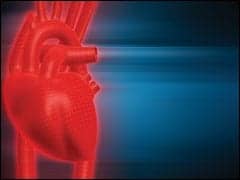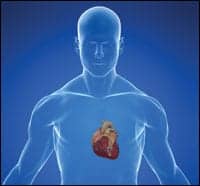Dynamic volume CT imaging is changing the future of cardiac care.

|
Aparadigm shifting computed tomography (CT) technology called dynamic volume CT has been introduced to the marketplace and is available for clinical use. Recent developments in CT technology are improving cost-effectiveness, increasing the quality of health care for patients, and creating new ways to diagnose a variety of diseases. With 320 0.5-mm detector rows, dynamic volume CT promises to improve patient outcomes by providing more accurate results in shorter periods of time.
Dynamic volume CT is the only system able to capture the entire heart in a single gantry rotation and show dynamic organ function. With up to 16 cm of coverage, it offers higher-quality images in shorter amounts of time and exciting new possibilities, such as real-time organ perfusion. It also reduces cardiac diagnosis time from days and hours to mere minutes, and has the potential to reduce cardiovascular health care costs by replacing several diagnostic tests with a single, more accurate, less invasive examination.
In my experience working with 320 detector row dynamic volume CT, it allows cardiologists to make faster, more comprehensive diagnoses, thereby ensuring optimal patient care. While traditional multidetector CT continues to prove its effectiveness in accurately and noninvasively diagnosing cardiovascular disease, the new dynamic volume CT system is a leap in technology with the ability to revolutionize the clinical pathway of cardiovascular disease patients.
Advances Over Previous CT Technology
The major advantage over previous CT technology is that 320 detector row dynamic volume CT allows cardiologists, for the first time, to see the entire heart and cardiac function in real time. The significant difference between dynamic volume CT and typical multidetector CT (for example, 64 detector row) is the ability to image the entire organ in less than a heartbeat and at a single moment in time.
For example, when imaging the entire heart using traditional multidetector CT, it takes approximately five to eight heartbeats to capture the entire heart. These multidetector images are then “stitched” together to create a full view of the scanned area, in this case the entire heart. The stitching process often creates clinical inaccuracies and artifacts (misregistration) in the image that make diagnosis challenging. If the patient’s heart rate is irregular, the heart may be in different locations from beat to beat during the scan, resulting in the data not lining up. In addition, since the imaging happens over multiple heartbeats, capturing the contrast agent at the exact moment it moves through the proper region of the heart is challenging. If this moment is missed, the data quality may be impaired.

|
| Another leap forward with 320 detector row dynamic volume CT is the reduction of radiation dose to the patient. |
With 320 detector row dynamic volume CT, these issues are no longer a concern. Since dynamic volume images the entire heart in a single gantry rotation or in less than a heartbeat, there is no need to stitch together images nor any issue with contrast nonhomogeneity. This also means heart rate irregularities and arrhythmias are easier to image.
Radiation Dose Reduction
Another leap forward with 320 detector row dynamic volume CT is the reduction of radiation dose to the patient. Radiation dose from multidetector CT has always been a concern, particularly in younger patients whose lifetime cumulative radiation dose is always unknown. Since the 320 detector row dynamic volume CT tube is on for such a short period of time and there is no overlap scanning (as there is in 64 detector row imaging), radiation dose is significantly reduced. As an example, to image a 16-cm heart would take 20 rotations (6 to 9 seconds) around the patient using traditional multidetector CT. However, with 320 detector row dynamic volume CT, the same-size image can be captured in one rotation (less than a second).
In fact, we have scanned several patients using 320 detector row dynamic volume CT with only 2 to 3 millisieverts (mSv) of radiation, about half the dose of an invasive cardiac catheterization and a fraction of the dose used with traditional multidetector CT. At our center, the average dose of radiation the patient receives with dynamic volume CT is 4 mSv. Dynamic volume CT’s speed also allows us to use less contrast, such as 50 to 60 mL versus 80 mL or potentially more used in traditional multidetector CT.
Streamlining the Pathway
The new 320 detector row dynamic volume CT system has helped us minimize the number of studies needed to come to a definitive diagnosis. Our standard algorithm puts dynamic volume CT as the core technology in the workup of chest pain. Using it, we can avoid layering of testing and decide quickly whether a patient will be managed invasively or noninvasively. If there is severe disease that needs invasive management, the information obtained by dynamic volume CT is used to help the interventional cardiologist or cardiac surgeon plan and customize their approach.
As a result, we are beginning to see a reduction in the number of normal invasive cardiac catheterizations when 320 detector row dynamic volume CT is used as the “gatekeeper” to the cath lab. In fact, 25% of invasive cath lab procedures may be unnecessary, according to initial findings of the worldwide CorE 64 study, which were presented by Johns Hopkins University at the American Heart Association annual meeting in 2007. By reducing invasive cardiac catheterizations in all but high-risk patients or patients with severe disease, we avoid the risks of unnecessary invasive procedures, as well as additional radiation dose and contrast. This would also help lower health care costs.
We also are seeing a decrease in the use of nuclear perfusion in our practice. Because these studies have a higher false positive and false negative rate, as well as a manyfold higher radiation dose than dynamic volume CT, we strongly believe this will benefit patients. CT also is less costly than nuclear perfusion, so this will have an impact on reducing the greater than $1 billion per year Medicare reimburses for myocardial perfusion studies in the United States (CMS data 2007).
Since our 320 detector row dynamic volume CT is used in an outpatient center, we tend to see referrals for low to intermediate pretest probability chest pain. However, the value of this modality in the emergency department setting has great potential and will revolutionize the chest pain clinical pathway, leading to massive health care cost savings and improved patient care. I believe that reductions in emergency department evaluation time, as well as the ability to discharge patients with normal or mild disease, will improve patient care and the bottom line for hospitals in this time of financial pressure. A number of validation trials are currently under way in this area.
Clinical Applications
One of the criticisms of both invasive cath and cardiac CT is they show only anatomy, not perfusion. However, 320 detector row dynamic volume CT solves this problem as it provides both anatomy and perfusion in a single, low-dose modality. Other CT systems are unable to perform perfusion studies because of the multiheartbeat acquisitions as well as the very high radiation doses required.
The protocols that allow us to perform myocardial perfusion studies with dynamic volume CT are actively being tested and perfected. Once these protocols are clinically available, we will see exactly how the blood is flowing into the myocardium. The diagnostic possibilities of these perfusion studies are vast and will help determine exactly how a particular lesion is impacting blood flow to the myocardium.
Our most common referrals for cardiac CT are low and intermediate probability chest pain, equivocal stress tests, cardiomyopathy of unknown etiology, electrophysiology applications, and preoperative cardiac evaluations. For these indications, the image quality and radiation dose savings of 320 detector row dynamic volume CT have increased the level of patient care at our facility. More rarely, we have seen studies ordered to evaluate masses, valve pathology, or other functional issues.
In the future, we believe dynamic volume CT will be used more and more as a “one-stop shop” since it can show complete anatomy—coronary and cardiac, function and perfusion, and viability—in a single, noninvasive, and less expensive study.
Additional benefits have been realized on patients with congenital heart disease. For these patients, the level of detail and real-time motion produced by 320 detector row dynamic volume CT allows cardiologists to more accurately assess areas of concern. These patients have a lifetime of potential scans ahead of them, so dynamic volume CT’s limited radiation dose is invaluable and safer for patients.
Cost Savings
In today’s health care environment, reducing costs to both the patient and imaging center or hospital are critical. By using 320 detector row dynamic volume as a “one-stop shop,” we can replace a variety of tests typically used to diagnose cardiovascular disease. This means that dynamic volume CT will help hospitals and imaging centers become more cost-effective by replacing several unnecessary tests with one simple exam. It provides faster, more accurate diagnosis and reduces the amount of time patients spend being triaged and diagnosed at a hospital. All of the factors combined provide safer exams, increased diagnostic capabilities, and lower health care cost overall.
Untapped Potential
CT technology has truly come a long way over the past few decades. While multidetector CT technology was a significant breakthrough, 320 detector row dynamic volume CT is a quantum leap forward. At CVCTA Education and Nevada Imaging Centers, we are excited to be educating and conducting research with the next generation of CT technology, Toshiba’s Aquilion ONE dynamic volume CT. We have only begun to realize dynamic volume CT’s potential benefits and clinical applications, and are looking forward to discovering new applications in diagnosing and treating patients with cardiovascular disease.
Tony DeFrance, MD, is a clinical associate professor at Stanford University School of Medicine and national director of CT Workgroups for the Society of Cardiovascular Computed Tomography. For more information, contact .






